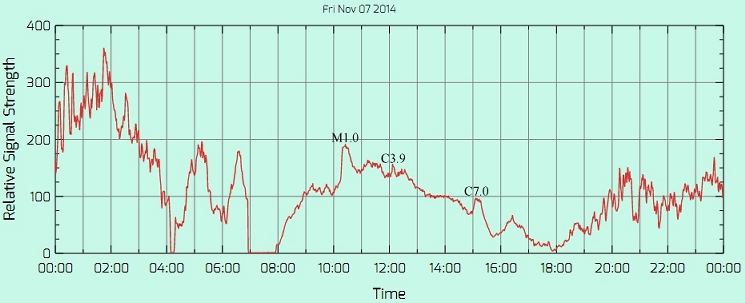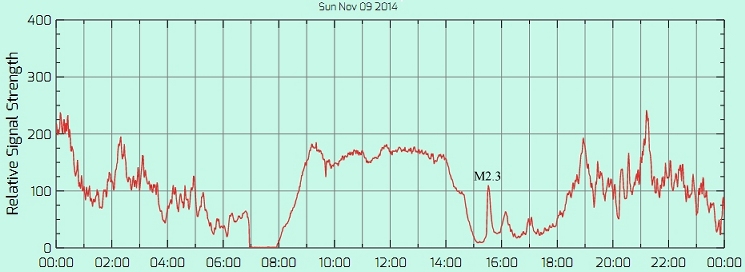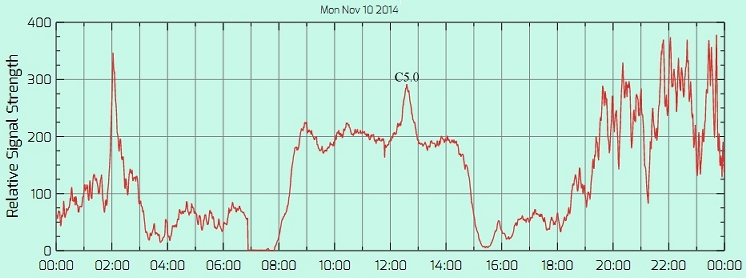|

Each
month a summary of sunspot activity is written and forms part of a
report sent to the Solar Section of the British Astronomical
Association (BAA)
and to The
Astronomer. Follow
the links below to read a
page summary of
sunspot activity. The McIntosh Sunspot Group Classification is used for
sunspot group descriptions.


January
2014
The
recent
moderately high
activity continued again throughout the month with the majority of
activity continuing
to be in the southern hemisphere.
On
the 2nd a complex and
moderately large sunspot group, AR 1944, was seen near the eastern limb
at
9°S/96° and of type Ekc. More of this group could be
seen on
the following day
when it was of type Fkc: the irregular leader was the largest sunspot
within the
group and there were many smaller follower penumbral sunspots. This
group was quite impressive when next
seen on the 6th being some 19° in length with an estimated
total
area of 1580
millionths – although the leader was the largest sunspot,
there
was now a very
elongated irregular follower sunspot in the north-south direction. In
between
there were many smaller penumbral sunspots.
On
the 7th the leader was on the central meridian and
which now had
several umbrae within it while the follower had decayed into many
penumbral
sunspots. The total area had reduced slightly to 1310 millionths. By
the 9th
both the leader and following sunspots had changed slightly and the
total area
had reduced again to 1010 millionths. There were further slight changes
over the
next few days as the group progressed towards the western limb. It was
last
seen on the 12th with an area of 1000 millionths (no observation was
made on
the 13th and it was not seen during the next observation on the 14th).
AR 1944
was seen with the protected naked eye on the 3rd as one sunspot, on the
6th,
7th and 9th as two sunspots and on the 10th as one sunspot. For the
observations when two naked eye sunspots were seen, it was the leader
sunspot
which appeared darker and more prominent compared to the follower. The
return
of AR 1944 was seen with the protected naked eye on the 31st.
Between
the 3rd and 6th a new
group had developed on the disk at a similar longitude as AR 1944 but
in the
northern hemisphere. This
group AR 1946
at 9°N/101° was of type Dac with an area of 90
millionths. By
the following
day, the 7th, it had grown to 230 millionths and by the 9th to 320
millionths
through the development of an irregular follower. When last seen
nearing the
western limb on the 12th it was just a small Dao group.
Observations
between the 14th and
25th showed several small groups.
The
largest were AR 1959 at 24°S/240° on the 25th with an
area of
300 millionths
(type Dac) and AR 1960 at 16°S/236° also on the 25th
with an
area of 200
millionths (type Hax).
Two
high latitude southern groups
were seen during the month: AR 1952 at 32°S/327°
between the
11th and 19th (type
Cai on the 14th) together with AR 1962 at 36°S/281° on
the 19th
(type Bxo).
Hydrogen Alpha:
On the 2nd a thin spike
prominence was seen on the NW limb while on the disk a few filaments
were seen
together with plage around AR 1936/1940 and following the large AR 1944
group
were also seen. On the 11th a triple spike prominence was seen on the
NW limb
while several filaments, one of which was particularly dark, were seen
on the
disk. Several plage were seen within and around AR 1944. On the 19th
all the
prominence and filaments seen were small – plage was seen
around
AR 1957 and
the high latitude southern hemisphere AR 1962.
VLF:
The
return of AR 1944 and AR 1946 around the
eastern limb was detected by the presence of VLF flares on the 28th as
shown
below. According to the NOAA Space Weather Prediction Center
(http://www.swpc.noaa.gov/ftpmenu/indices/events.html) the first three
flare
were from the returned AR 1944 (now AR 1967) while the forth was from
the
returned AR 1946 (now AR 1968).
|
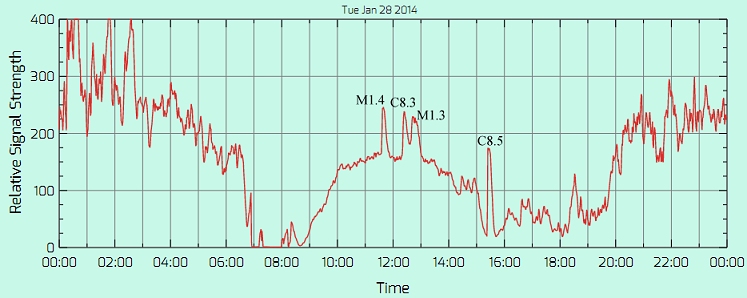
|
|
VLF
23.4 kHz flare
detections. 2014 January 28 (UT).
|


February
2014
The
recent
moderately high
activity continued again throughout the month, especially towards the
end of
the month and with the majority of activity continuing to be in the
southern
hemisphere.
The
return of the large group
from January, now AR 1967, dominated the solar disk at the start of the
month.
On the 1st it appeared as a complex Fkc group at
11°S/112°
comprising of small
penumbral sunspots at the leading part of the group, a large asymmetric
follower with an irregular penumbral sunspot in between (there were
also a few
other small sunspots within the group). It had an estimated area of
1200
millionths. On the following day, with the group nearing the central
meridian,
the three portions from the previous day had merged to form a large
very
irregular elongated sunspot. Within this there were many umbrae, the
largest of
which were towards the middle and following parts. Several small
penumbral
sunspots and pores were surrounding the main sunspot and the total area
was
1620 millionths – an impressive sight. By the 8th only an
irregular Hkx sunspot
was seen nearing the western limb. AR 1967 was seen with the protected
naked
eye on the 1st, 2nd, 3rd and 6th.
To
the north of the large sunspot
group was AR 1968 at 11°N/112° of type Eac on the 1st
with an
area of 220
millionths (possibly the return of AR 1946) - it consisted of a string
of small
penumbral sunspots. On
the 2nd it had
developed a larger follower but lost some of the leading penumbral
sunspots to
just pores. On the 8th, close to the limb, it had returned to a
collection of
several penumbral sunspots.
The
observation on the 15th
showed a collection of four groups at similar southern latitudes spread
across
the disk. The largest of these was AR 1974 at
11°S/352°. It was
initially seen
as a small Eac group on the 8th but by the 15th it had developed into
an Ekc
group with an area of 830 millionths through being comprised of many
irregular
penumbral sunspots. It was of a similar appearance and size on the 16th
when
seen approaching the western limb.
Three
naked eye sunspots were seen on the 15th, the darkest being AR 1974,
while two
were (just) seen on the 16th.
On
the 21st three nearby groups
were seen approaching the central meridian.
These
were AR 1984 at 16°S/221° type Bxo, AR 1981
type Eao at 6°S/215°
and AR 1982 type Dac at 11°S/206°. The largest of these
was AR
1982 at 340
millionths. On the following day it became more difficult to separate
AR 1981
and 1982 as there was only about 5° difference in latitude and
the
following
part of AR 1981 overlapping in longitude of AR 1982.
There
was a greater longitude overlap between
these two groups on the 24th. These groups were seen approaching the
western
limb on the 27th.
The
24th showed the third return
of AR1944/AR 1967 as a thin penumbral Hkx sunspot very close to the
limb at
13°S/106° (now AR 1990). By the 26th it could be seen
that the
group had
decayed significantly since its previous rotation since it was now a
small
single Hax sunspot with an area of 160 millionths. On the 27th it had
grown
slightly to 220 millionths when a couple of leading pores were also
seen. The
solar disk was seen with 11 groups on the 27th, the highest seen during
the
month.
Hydrogen Alpha:
The
most interesting Hα activity from four
observations was on the 2nd when three flares were seen between 13h 55m
to 14h
45m UT (with a cloud break between 14h 05m to 14h 25m). These flares
were seen
within the large sunspot group AR 1967 and the northern group AR 1968
– various
areas of plage were seen within these groups at the beginning of the
observing
period. From 14h 02m until the clouds at 14h 05m, a compact bright
region was
seen within AR 1967 (a M1.7 flare) – this flare was not seen
after resuming
observations at 14h 25m. At this time a flare, C7.8, was seen with AR
1968 as
elongated bright areas. After this flare faded, another C7 flare
brightened
within the same group between 14h 33m to 14h 45m – this had
the
appearance of a
ribbon within the group.
|
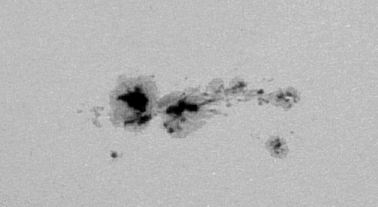
|
|
2014
February 02, 1317 UT. Large sunspot group AR 1967.
|


March
2014
The
moderately
high activity of
recent months continued but in the form of many small/medium sized
groups
rather than fewer larger groups. Based
on 17 observations spread throughout the month, a total of 39 separate
groups
were recorded from the 1st to 30th.
Again
the southern hemisphere was the more dominant with
several groups seen
at high southern latitudes.
On
the 1st the largest group seen
was AR 1991 at 24°S/89° of type Eao which just
comprised two
irregular
penumbral sunspots with a total area of 280 millionths. By the 5th
there had
been an increase in the number of sunspots spread throughout this group
but the
penumbral sunspots had reduced in size to give an area of 120
millionths. The
group continued to decay with just an Hsx sunspot seen on the 7th and
an Axx
sunspot on the 9th when it was nearing the western limb. The
next moderately sized group was AR 2002
which was initially seen as a Bxo type near the western limb on the 9th
at 17°S/322°.
By the following day the group had developed into type Dac with an area
of 240
millionths – the follower was the largest penumbral sunspot. When
next seen on the 14th AR 2002 had formed
into an Eac group, now near the central meridian, with an area of 290
millionths with many small penumbral sunspots spread throughout the
group. It
was of similar form on subsequent days and was last seen on the 17th.
On
the 14th a solitary Hax
sunspot, AR 2005, was seen at 12°N/263° with an area of
280
millionths. It was
of a similar type on the 15th but on the 16th two small sunspots had
formed
nearby. Just one of these additional sunspots was seen on the 17th and
by the
20th the group was a single Hax sunspot once again. It was last seen on
the
24th very close to the western limb. During the latter part of the
month, the
largest group was AR 2014 which was seen near the eastern limb on the
20th as a
Dso group at 13°S/168°. By the 24th it changed slightly
to type
Dac with an
area of 240 millionths and it comprised of several small penumbral
sunspots
throughout the group with the leader being the largest. As the group
progressed
towards the western limb, it reduced in size such that on the 29th it
was 150
millionths and type Dso. It was last seen as type Dso very close to the
limb on
the 30th when it comprised of just two small penumbral sunspots.
Hydrogen Alpha:
Based
on 9 observations, the most striking
prominences were a combined filament/prominence on the 9th on the SE
limb,
another filament/prominence on the 28th on the SE limb and a twin flame
prominence on the NE limb also on the 28th. Many long thin filaments
were seen
throughout the month while an extensive region of plage were seen
around AR
1998 (a Csi group at 10S/359) on the 9th.
|
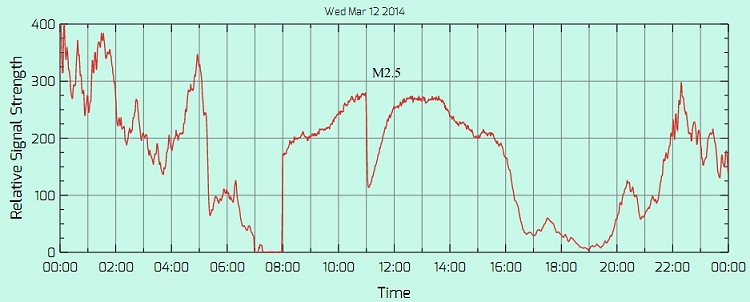
|
|
VLF 23.4 kHz flare
detections. 2014 March
12 (UT).
|


April
2014
As
during March
the moderately
high activity continued through the presence of many small/medium sized
groups. Although
the southern
hemisphere
was the more dominant there were many groups in the north.
The
largest of five group seen on
the 5th was AR 2021 at 13°S/70° of type Dac at 280
millionths
which consisted
of several small penumbral sunspots throughout the group. On the 8th a
Dso
group was seen near the eastern limb – AR 2032 at
12°N/270°. As this group
rotated on to the disk, it was type Esc with, on the 10th, an area of
320
millionths. It lost its middle penumbral sunspot by the 12th to leave a
few
pores between the leader and follower sunspots. Even these had
disappeared by
the 14th with the group just past the central meridian.
AR
2032 was last seen close to the western
limb on the 19th.
Also
on the 14th a small Dsc
group had developed on the disk at 16°S/246° at 60
millionths
– AR 2036 was
comprised of many small penumbral sunspots. By the following day its
appearance
had changed quite significantly to become two main irregular penumbral
sunspots
with an area of 350 millionths and was visible with the protected naked
eye. On
the 16th the follower had increased in size while the leader had split
into two
– the group was now of type Dkc with an area of 380
millionths
and again
visible with the protected naked eye. On this date it was near the
central
meridian. Observations on the next 3 days, the appearance of this group
changed
each day but it was of type Dac on each date. AR 2036 was last seen
close to
the western limb on the 21st.
The
period 15th to 19th showed an
increase in the number of groups visible in both hemispheres (although
there
were more in the south). For example on the 19th, ten groups were seen
– in
addition to AR 2036, the largest groups were AR 2034 at
6°N/243° of type Eao at
370 millionths, AR 2035 of type Dac at14°S/220° at 280
millionths and AR 2042
at 17°N/163° of type Dao at 260 millionths. By the 26th
AR 2042
was now of type
Hsx and it was last seen near the limb on the 27th. Also on the 27th a
single
Hsx sunspot had rotated onto the disk – by the following day
a
follower had
appeared to make this group, AR 2049 type Dso at
7°S/15°. On
the 30th it had an
area of 310 millionths and was of type Dac.
Hydrogen Alpha:
A faint cloud type prominence was
on the NW limb on the 14th – a thin piece of hydrogen was
seen
extending down
from one end of the cloud to the limb. On the 15th a flare close to the
SE limb
was in progress at the start of the observing period at 12h 50m UT.
Just
further onto the disk was an almost semi-circular filament. The C3.6
flare,
seen as an almost circular region, had faded by 13h 00m UT. On the 19th
at 15h
30m UT a bright short spike prominence was seen on the SW limb until
15h 40m.
This region was quite active with a nearby prominence seen to extend in
height
over the next 10 minutes. A complex S shaped prominence was seen on the
NW limb
on the 21st – it comprised several segments that were
detached
from the limb up
to a height of 90,000 km.


May
2014
Activity
continued at moderately
high levels throughout the month but again this was only due to the
presence of
many small/medium sized groups. The
southern
hemisphere was the more dominant again especially during the latter
part of the
month when no northern groups were seen from all observations made
between the
22nd & 25th and 29th & 31st inclusive.
The
first observation of the
month on the 3rd showed three similarly sized southern D type groups.
These
were AR 2051 at 10°S/57° of type Dko at 270 millionths,
AR 2047
at 18°S/48° of
type Dac at 270 millionths and AR 2049 at 7°S/14° of
type Dac
at 280
millionths. The irregular leading sunspot of AR 2051 had decayed into
several
smaller penumbral sunspots by the following day and it had decayed
further when
last seen near the limb on the 5th. AR 2047 similarly reduced in size
as it
neared to limb, last being seen as an Hsx sunspot on the 6th. AR 2049
continued
as a D type until it lost it follower penumbral sunspots by the 6th
when it was
of type Csi at 150 millionths and then to an Hsx group on the 7th at 90
millionths.
Also
on the 6th two northern E type groups had
rotated onto the disk. The first of these was AR 2055 at
13°N/270°. On the 7th
it had an area of 430 millionths but when next seen on the 13th, it had
reduced
in size to 270 millionths and now of type Eac. The leader was to
largest
sunspot in the group. Over the next few days it became type Dao, Cso
and then
Hsx on the 16th when close to the western limb. The other group, AR
2056 at 4°N/259°
was of type Dai on the 14th at 190 millionths. Although it lost many of
its
smaller sunspots as it progressed towards the limb, it was of type Eao
when
last seen on the 17th.
From
the 17th onwards the number
of groups reduced to four or five from the 22nd onwards. Of
particular note during this period was AR
2065. This group
was
initially seen as
an Axx sunspot on the 16th at 17°S/144° not too far
from the
eastern limb. Nothing
of this group
was
seen again until
the 23rd when a Dso group was seen at 19°S/147°. This
group had
an estimated
area of 190 millionths on the 24th before nearing the limb on the 25th.
The
month ended with five small southern groups, the largest being AR 2075
of type
Cso at 8°S/17° with an area of 60 millionths.
Hydrogen Alpha:
On
the 4th, at 16h20m UT, a ‘pick-axe’ shaped
prominence was seen on the NW limb together with a faint cloud of
hydrogen
suspended above the SW limb. An extensive and elongated region of plage
was
seen around AR 2060 on the 18th together with other regions of plage
around ARs
2063, 2066 and 2068. On the 31st a series of prominence were seen along
the SE
limb.


June
2014
On
the 4th a
small Bxo group was
seen near the eastern limb at 11°S/260°. This group, AR
2080,
developed into a
small Dao group by the following day, into a Dai group by the 6th and
then into
type Dac on the 7th with an area of 200 millionths. This development
continued
such that on the 8th AR 2080 comprised of an irregular leading
penumbral
sunspot and several small following penumbral sunspots. The leading
sunspot
developed further when seen on the 10th when the group was seen at its
maximum
area of 340 millionths. As it neared the limb, fewer sunspots were seen
such
that on the 13th only an extended Dko sunspot remained. On the 6th a
Bxo group
developed on the disk just to the south and east of AR 2080 –
this was AR 2085
at 18°S/253°. This group also developed rapid such that
by the
following day,
it was of type Dac and by the 10th it was of type Ekc at 470 millionths
with a
larger leader than AR 2080. By the 12th it has also started to decay
such that
it was last seen as type Eko on the 13th.
On
the 10th an Hsx sunspot was
seen close to the limb – this was AR 2087 at
18°S/154°.
By the 12th it could be
seen that this group was of type Dsc. It was of the same type on the
13th with
an area of 230 millionths. During this period it was very active in
Hα (see
below) but this was not obvious in white light. On the 17th AR 2087 was
just
past the central meridian was of type Dsc with an area of 180
millionths. It
was last seen as a Cso group on the 21st close to the western limb.
Activity
was particularly low on
the 23rd when only one group was seen – AR 2096 at
10°N/353°. Additional small
group was seen on subsequent observations but on the 29th two new
larger groups
appeared around the eastern limb – AR 2104 and 2107 at
8°S/269° and 20°S/260°
respectively. AR 2104 was seen as an irregular Dac group on the 30th
while AR
2107 just comprised on two asymmetric penumbral sunspots to form a Dao
group.
Hydrogen Alpha:
On the 1st several prominences
were seen on the E limb including a spike prominence with a cloud of
hydrogen
extending from the end of the spike to an estimated height of 120,000
km. An
observation on the 8th showed a long broken S shaped filament towards
the
middle of the disk. This was also seen on the 10th but only as two
fragments.
Also on the 10th at 16h 45m UT a small bright region was seen on the
disk near
the E limb – this was a C1.5 flare in AR 2087 (the same
region
that produced X2.2
and X1.5 flares earlier the same day). Nothing was seen at 17h 45m. A
further
flare was seen within the same AR on the 12th at 18h 25m –
two
small bright
regions were seen (there had been a M1.3 flare at 18h 13m and a C7.3 at
18h 23m).
The flare had subsided by the end of the observing session at 18h 45m
UT. A nice
arch prominence was seen on the 21st on the NE limb at 18h 20m while on
the
opposite limb a floating prominence, parallel to and about 100,000 km
above the
limb was also seen.


July
2014
An
unusual month: moderately high
activity during the first week
including four naked eye sized sunspots before significantly reducing
towards
the middle of the month including no sunspots on the 17th and then
slowly
increasing activity towards the end of the month.
On
the 1st all four northern
groups were all small and of type Bxo.
However,
in the south there were two larger complex groups
which were at
almost the same longitude. AR
2104 of
type Dkc at 10°S/268° was slightly to the north and
west of AR
2107 of type Dao
at 20°S/260°. Both groups had passed around the limb a
few days
previously. AR 2104
comprised of a
symmetric leader and a larger irregular follower which was elongated in
latitude: it had a total estimated area of 470 millionths. By the
following
day, the follower has split such that there were now several irregular
sunspots
within the group with an area of 590 millionths. On the 3rd several of
the
sunspots had merged to give a much larger irregular leader. Next
the leader started to split into several
sunspots and the followers reduced in size such that by the 8th AR 2104
was a
small Dsi group at 120 millions. The
other southern group from the 1st, AR 2107, was of type Dac up to the
6th when
it lost it leading smaller sunspots to comprise of a single asymmetric
sunspot
with a few surrounding pores. It obtained an area of 380 millionths on
the 2nd
while becoming smaller on each subsequent day to being 140 millionths
on the
8th when it was a single Hax sunspot.
On
the 2nd two small southern
groups has appeared near the eastern limb.
The
first of these, AR 2108, had formed on the disk at
7°S/239° as a
small Cso group. By the 4th a follower penumbral sunspot had developed
to form
a Dsi group of area 110 millionths. Significant development took place
such
that just two days later, on the 6th, AR 2108 has become a complex Dkc
group of
580 millionths (i.e. its area increased by a factor of five in two
days). It
comprised of an irregular leader containing many umbrae, a more
symmetric
follower and many small pores around the group. On the following day,
the
leader had changed shape to become a larger more symmetric sunspot: now
the
total area was 740 millionths. This group had changed again on the 8th:
now the
leader was slightly smaller but the following sunspots had merged into
one
sunspot and the area increased slightly to 770 millionths. The
other group, AR 2109 at 7°S/219°, was
initially an Hsx sunspot close to the eastern limb. By the 3rd a
smaller
follower appeared from around the limb. Additional sunspots developed
within
the group by the 4th but by the 6th a complex group with a dominant
leader had
formed: it had an area of 610 millionths. Over the next two days, the
leader
reduced slightly but it still had a area of 600 millionths and was of
type Dkc
on the 8th.
AR
2104 was seen with the
protected naked eye on the 2nd, 3rd and 4th while on the 6th four naked
eye
sunspots were seen: AR 2104, 2107, 2108 and 2109 with the latter two
groups
being much easier to detect. On the 7th three sunspots were seen with
the
protected naked eye while on the 8th, two were seen (AR 2108 and 2109).
The
next observation on the 15th
showed a very different level of activity – just one small
Hsx
sunspot, this
being an Hsx sunspot at 9°N/163° with an area of 30
millionths.
On the 17th no
sunspots were seen while on 18th three small groups has developed on
the disk.
Two of these had decayed by the 21st when only a Cso group at
20°S/65° with
area 50 millionths remained. Although the number of groups increased
towards to
end of the month, none were particularly large. On the 31st eight
groups were
seen, the largest being AR 2130 at 7°S/229°, of type
Dac at 330
millionths.
Hydrogen
Alpha:
On the 19th a cloud of hydrogen
well above the NE limb was seen while on the 22nd a tall spiky
prominence with
a curved piece of hydrogen almost parallel to the limb sitting on top
of the
spike was seen on the NW limb. This latter prominence had an estimated
height
of 110,000 km above the limb. On the 24th a flame type prominence was
seen on
the SW limb. Numerous filaments and regions of plague were seen
throughout the
month.


August
2014
Activity
was
moderately high
during the month but all groups seen were not particularly large. For
example
the largest of eight seen on the 1st was AR 2132 at
18°S/210°
of type Dac at
310 millionths. It had been of type Axx the previous day when it was
close to
the eastern limb. It remained a D type group over subsequent days
before
extending in longitude to become a small type Eac group on the 6th. As
it
neared the western limb AR 2132 reduce to type Hsx on the 10th. To
the north and west of AR 2132 on the 1st
was AR 2130 at 06°S/228° of type Dac and size 190
millionths.
Although it
reduced in size on subsequent days, it extended in longitude to become
type Fao
on the 2nd through the presence of follower pores. A similar number of
small
sunspots were seen on the 3rd and 5th but by the 7th, the group was
last seen
as type Bxo.
Towards
the middle of the month,
the number of groups reduced to just three on the 10th. One of these
was AR
2135 at 13°N/128° which was initially seen as type Cso
on the
6th close to the
eastern limb. A
follower sunspot
developed by the following day and it was of type Eai on the 9th with
an area
of 230 millionths. As it progressed towards to central meridian, it
started to
reduce in size and type, to be a single Hsx sunspot on the 16th when
near the
western limb.
Although
the number of group seen
increased again, with nine seen on the 23rd, none of these were
particularly
large. The most interesting was AR 2146 at 10°N/346°
which was
initially seen
at an Hsx sunspot close to the eastern limb on the 17th. This was
accompanied
by small pores on the 20th and 21st and then by another penumbral
sunspot on
the 23rd which appeared to merge together by the following day to make
a
complex penumbral sunspot – this together with another small
penumbral sunspot
made the group type Dko with an estimated area of 310 millionths. It
was last
seen as an Hax sunspot close to the western limb on the 27th.
Hydrogen Alpha:
An extensive hydrogen ‘cloud’
prominence was seen above the SE limb on the 2nd which appeared
attached to
limb on the following day, having rotated further onto the solar disk.
Another detached
prominence was seen on the SW limb on the 23rd as a series of elongated
blobs
of hydrogen. A more complex prominence was seen on the same day on the
opposite
NE limb – this included a jet extending parallel to the limb
towards the solar
equator.
Filaments
were seen on each of
five observing days – long examples were seen on the 2nd, 3rd
and
again on the
23rd. Plage was
seen
associated with AR
2130 and 2132 on the 2nd and 3rd, AR 2135 on the 9th, AR 2139, AR 2141
and 2143
on the 17th and with AR 2146 and AR 2149 on the 23rd.


September
2014
Activity
was
moderately high
during the month but all groups seen were not particularly large. For
example
the largest of eight seen on the 1st was AR 2132 at
18°S/210°
of type Dac at
310 millionths. It had been of type Axx the previous day when it was
close to
the eastern limb. It remained a D type group over subsequent days
before
extending in longitude to become a small type Eac group on the 6th. As
it
neared the western limb AR 2132 reduce to type Hsx on the 10th. To
the north and west of AR 2132 on the 1st
was AR 2130 at 06°S/228° of type Dac and size 190
millionths.
Although it
reduced in size on subsequent days, it extended in longitude to become
type Fao
on the 2nd through the presence of follower pores. A similar number of
small
sunspots were seen on the 3rd and 5th but by the 7th, the group was
last seen
as type Bxo.
Towards
the middle of the month,
the number of groups reduced to just three on the 10th. One of these
was AR
2135 at 13°N/128° which was initially seen as type Cso
on the
6th close to the
eastern limb. A
follower sunspot
developed by the following day and it was of type Eai on the 9th with
an area
of 230 millionths. As it progressed towards to central meridian, it
started to
reduce in size and type, to be a single Hsx sunspot on the 16th when
near the
western limb.
Although
the number of group seen
increased again, with nine seen on the 23rd, none of these were
particularly
large. The most interesting was AR 2146 at 10°N/346°
which was
initially seen
at an Hsx sunspot close to the eastern limb on the 17th. This was
accompanied
by small pores on the 20th and 21st and then by another penumbral
sunspot on
the 23rd which appeared to merge together by the following day to make
a
complex penumbral sunspot – this together with another small
penumbral sunspot
made the group type Dko with an estimated area of 310 millionths. It
was last
seen as an Hax sunspot close to the western limb on the 27th.
Hydrogen Alpha:
An extensive hydrogen ‘cloud’
prominence was seen above the SE limb on the 2nd which appeared
attached to
limb on the following day, having rotated further onto the solar disk.
Another detached
prominence was seen on the SW limb on the 23rd as a series of elongated
blobs
of hydrogen. A more complex prominence was seen on the same day on the
opposite
NE limb – this included a jet extending parallel to the limb
towards the solar
equator.
Filaments
were seen on each of
five observing days – long examples were seen on the 2nd, 3rd
and
again on the
23rd. Plage was
seen
associated with AR
2130 and 2132 on the 2nd and 3rd, AR 2135 on the 9th, AR 2139, AR 2141
and 2143
on the 17th and with AR 2146 and AR 2149 on the 23rd.


October
2014
Activity
during the month was
dominated by the appearance of the large sunspot group AR 2192. This
group was
first seen on the 18th close to the eastern limb at
12°S/247°
as an Fkc type
where the follower was the largest penumbral sunspot. From this
observation it
was clear that this was a large sunspot group – indeed it
became
the largest of
this solar cycle. On the following day more of the large irregular
follower
could be seen which included a main umbra and several smaller umbra
sunspots. Its
total area was estimated at 2200 millionths. By the 21st AR 2192 became
much
more complex with many umbrae and several regions of photosphere within
the
main penumbral sunspot and its area grew to 2770 millionths. On the
following
two days the group remained a similar size although more photosphere
could be
seen in the middle portion of the group. In fact by the 27th there had
been a
split with the follower being the largest penumbral sunspot –
its
area had
reduced to 2280 millionths. AR 2192 was last seen on the 28th. Throughout
its passage across the solar disk,
AR 2192 remained type Fkc.
AR
2192 was seen with the protected naked eye on
the 19th, 20th, 21st, 22nd, 23rd, 25th, 27th and 28th (from the 21st to
23rd it
was seen as an elongated sunspot while on the 25th two distinct naked
eye
sunspots were seen but on the 27th and 28th it was once again seen as
one
sunspot).

Hydrogen
Alpha:
The
most
spectacular Hα event during
the month was the observation of a X2.0 solar flare within AR 2192 on
the 27th.
This observation began at 14:20 UT when multiple bright regions were
seen
within the group. The size and brightness of these changed rapidly over
the
next 10 minutes as the flare developed past type X1 at 14:25 towards
the broad
X2 peak at 14:47 UT. A switch from visual observation to imaging showed
flares
within the main penumbral sunspot (close to the two main umbrae), in a
region
between the leader and follower together with a thin strand of bright
hydrogen
towards a circular flare region to the south west away from the group
itself.
These bright regions gradually faded towards the end of the observing
period at
15:30 UT when the flare was still of type M4 (see images below).
In
addition a C5.8 flare was seen
within AR 2192 on the 19th: at 12:20 UT a bright ribbon was seen to the
north
of the main penumbral sunspot while by 12:25 UT just two bright patches
remained. Other Hα activity included an extensive hedgerow
prominence along the
E limb on the 5th which extended for some 20° along the limb.
Several small
filaments were seen around AR 2192 on the 23rd.
Long
filaments were seen on the 23rd, 27th and 31st, the
latter being a
combined prominence/filament extending over the NW limb. A high
arch/loop
prominence was seen on the E limb on the 31st with the maximum height
being
about 100,000km.
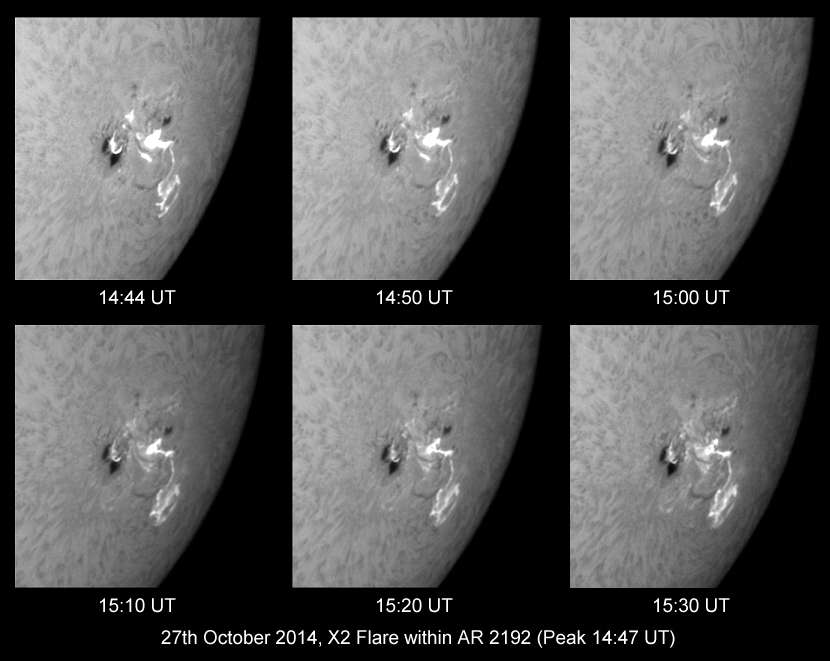
VLF
Receiver:
Many
solar
flares were detected
during the month using a 23.4 kHz VLF receiver include three X flares
associated with AR 2192 that occurred during daylight hours as shown
below:
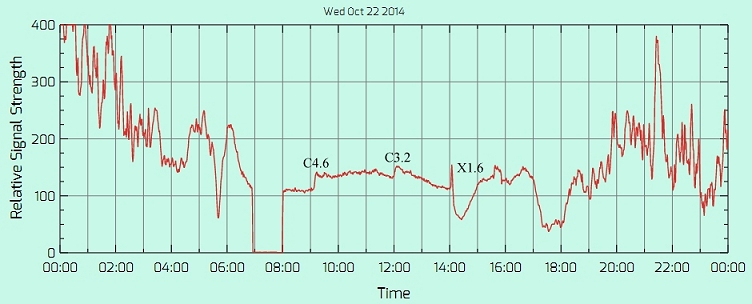
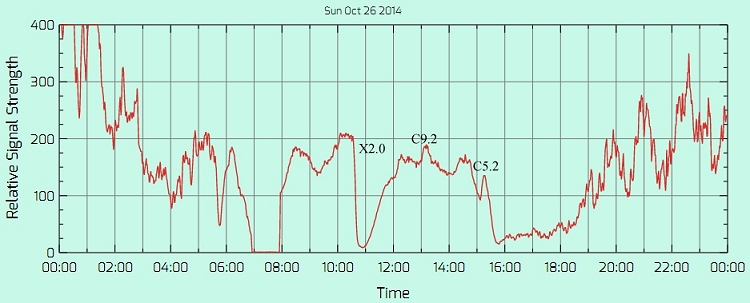
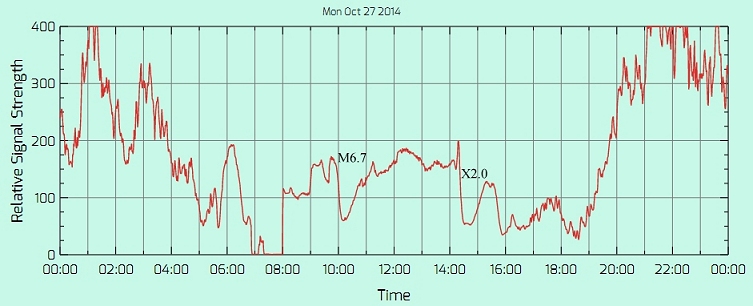


November
2014
On
the 4th a
small Dsc
group, AR
2205, was seen close to the eastern limb at 16°N/12°.
By the 7th it had become
an Eac type with an area of 250 millionths: it comprised a number of
small
penumbral sunspots and it was the largest group on the solar disk. The
shape,
size and number of penumbral sunspots had changed by the 9th (now a Dac
group) and
again on each of the next two following days indicating an active group
(AR
2205 was close to the central meridian on the 10th). Its total area
remained
similar on each of these days before reducing to 100 millionths when AR
2205
was last seen on the 12th.
Also
on the 12th an extensive
area of faculae was seen near the limb in the south-east quadrant which
indicated the expected return of the large October group AR 2192.
Indeed, the
next observation on the 19th showed a large irregular penumbral sunspot
at 13°S/243°,
AR 2209. Within the sunspot were several umbrae together with a region
of
photosphere near the centre of the sunspot. In the leader position
within the
group was a smaller regular penumbral sunspot. On the following day a
few pores
were seen between the leader and follower sunspots: the group was of
type Fko
with an estimated area of 1050 millionths. The next observation on the
24th
showed AR 2209 close to the western limb and of a similar form as
previously
(the region of photosphere still visible within the larger follower
sunspot).
AR 2209 was seen with the protected naked eye on the 19th and 20th.
Another
naked eye sunspot was
first seen on the 20th close to the limb at 12°S/163°.
On the 24th AR 2216 was
seen as type Dkc with an area of 620 millionths. The majority of the
size of
the group was through the irregular leader penumbral sunspot. This
group had
drastically reduced in size by the 29th when it was of size 120
millionths and
type Dao. On the 30th it comprised of just a small leader &
follower
sunspot. AR 2216 was seen with protected naked eye on the 24th.
Observations
on the 29th and 30th
showed an increase in the number of groups seen with nine on each date
(the
highest of the month). Included was AR 2222 at
18°S/83°. On the 29th this
bipolar group of type Eac comprised an asymmetric leader, an irregular
follower
and several pores in between. It
had an
area of 520 millionths. On the 30th the leader extended slightly while
the
follower reduced in size slightly to make the group type Eko with area
460
millionths. AR 2222 was seen with protected naked eye on the 29th and
30th.
Hydrogen
Alpha:
On
the 1st an
extensive
hedgerow
prominence was seen on the SW limb, while on the NE limb a small
combined
filament/prominence was seen together with small detached prominence
closer
towards the equator. On the 9th an irregularly shaped prominence was
seen on
the SE limb: several streams of hydrogen were seen extending almost
parallel to
the solar limb. A small loop prominence was also seen on the NE limb. A
spike and arch prominences were seen on the
western limb on the 29th. A couple of long filaments were seen in the
SW
quadrant on the 29th. The most extensive plage seen from the three
observations
was on the 29th around AR 2222.
VLF
Receiver:
Several
solar flares were
detected during the month using a 23.4 kHz VLF receiver include an M2.3
flare
during the sunset part of the VLF plot as shown below:
On
the 4th a
small Dsc
group, AR
2205, was seen close to the eastern limb at 16°N/12°.
By the 7th it had become
an Eac type with an area of 250 millionths: it comprised a number of
small
penumbral sunspots and it was the largest group on the solar disk. The
shape,
size and number of penumbral sunspots had changed by the 9th (now a Dac
group) and
again on each of the next two following days indicating an active group
(AR
2205 was close to the central meridian on the 10th). Its total area
remained
similar on each of these days before reducing to 100 millionths when AR
2205
was last seen on the 12th.


The
naked eye
group from the end
of November, AR 2222 at 18°S/83°, had changed from a
Eko type
on November 30
into a single Hkx sunspot on the 6th. It was a quite irregular shaped
sunspot
and it had an area of 560 millionths. It was of a similar shape on the
7th and
was seen very close to the western limb on the 8th. Four groups were
seen on
the 8th – on subsequent days more groups were seen such that
by
the 11th there
were seven and by the 14th eleven. One of these was seen at an
unusually high
latitude for this part of the solar cycle. This group, AR 2236, was
first seen
on the eastern limb on the 11th at 30°N/240°.
Observations up
to the 20th
showed AR 2236 as a single Hax type with a maximum area of 170
millionths on
the 14th.
Between
observations on the 13th
and 14th, a Dso group had developed on the disk at
16°S/238°.
This group, AR
2242 grew rapidly between the 14th and 16th with its area increasing
from 80 to
680 millionths when it was of type Dkc and comprised of an irregular
leader, a
smaller irregular follower and with many pores throughout the group.
With this
group near the central meridian on the 17th, the leader had grown
again,
extending in longitude and containing many umbrae. The size of the
following
penumbral sunspots had reduced. Its area was estimated at 790
millionths. The
leader had increased again by the 19th when AR 2242 became type Ekc
with an
area of 1140 millionths. By now the main penumbral sunspot was quite
complex in
shape with many umbrae within it. A small penumbral sunspot had formed
in the
leading position within the group while just a small follower was seen.
By the
next day the main sunspot had split into three parts and its area
almost
halving to 650 millionths. AR 2242 had rotated around the western limb
by the
next observation on the 24th.
During
this period another medium
size group developed slightly to the north and east of AR 2242. This
was AR 2241 at 8°S/216° and it
was
initially seen as an Hsx on the 13th near the limb. It was a small Dsc
group on
the 14th before becoming type Eac on the 16th with an area of 180
millionths.
By the following day it developed quite rapidly by doubling its size to
440
millionths and comprising a string of penumbral sunspots with the
follower
being quite irregular. This group grew slightly by the 19th at 570
millionths
(and near the central meridian) before reducing to 430 millionths on
the 20th.
Further decay must have taken place since when seen next on the 24th
only an
Hsx sunspot remained. AR
2241 was last
seen near the western limb on the 25th.
AR
2242 and AR 2241 were seen with protected naked eye on
the 19th (AR
2241 comprised of two naked eye sunspots).
|
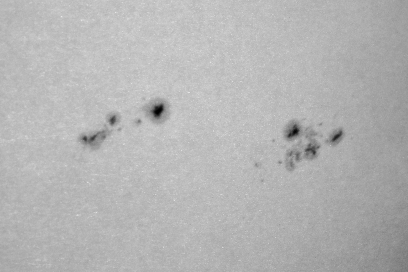
|
|
2014 December
19. AR 2241 (left) and AR 2242 (right). East left.
|
From
the 24th
to the end of the
month six groups were seen on each of five observing days, none of the
groups
were of particularly note. The largest seen was AR 2253 at
4°S/357° of type Eac
and size 390 millionths on the 31st.
Hydrogen Alpha:
On
the 6th an
irregular arch
prominence was seen on the SE limb, there were a few filaments
including one
which had the appearance of a 90° bend and plage around AR
2222. On
the
following day the arch prominence had disappeared but the bent filament
was
still visible but included a slightly less sharp bend. Two small
neighbouring
spike prominences were seen on the NW limb. Observing on the 14th a
multiple
arch prominence was seen on the SE limb while near equator on the E
limb a
faint tree shaped prominence was seen – some of the
‘branches’ were
disconnected from the main ‘trunk’. Plage was seen
around
AR 2242.


Page
created on 31 December 2013.
|

